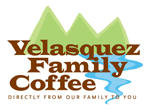June 2012 Coffee News
-Prairie meets Rain Forest
-What would you ask a Honduran Coffee farmer?
-Update from the Poised Century
Prairie meets Rain Forest
This past Memorial Day weekend our family had the pleasure of traveling to the open South Dakota prairie to join with Cathy's extended family -- all of her Eberhart aunts and uncles and most of her cousins -- at the beautiful R&R Pheasant Hunting Lodge just a few miles east of the Missouri River. Our time in the prairie reminded us once again of the sharp contrasts between the Dakota landscape where Cathy grew up and the tropical rain forest where Guillermo comes from.
We begin our study in contrasts by first acknowledging that we find both the open prairie and the tropical rain forest stunningly beautiful. And because a picture is truly worth a thousand words, feel free to stop reading and click over to Flickr to see a few shots Cathy's brother generously shared with us of the Prairie and a few of our favorites from the Rain Forest.
The first obvious difference is flatland versus mountains. A South Dakotan out on the open prairie can truly see as far as their eyes can see. A Honduran farmer literally needs to be careful not to "fall out of his field." Then there are the trees, or lack thereof, especially in the western Prairie where they are few and far between, compared to the lush vegetation of the tropical forest. Leave a piece of pasture in the rain forest untouched and it will return to forest within a year. Cathy's brothers, who helped weed their uncle's shelter belt on his SD farm a few summers in a row, can tell you how hard it is to establish trees in the prairie. Temperature is a factor as well. South Dakota experiences the extremes of 100 degree heat in the summer and minus temperatures in the winter. Meanwhile, the coffee farm is usually comfortably between 65 and 85. And of course there is rain -- an average annual rainfall of 20 inches in SD compared to a whopping 200 inches per year in Honduras -- which combined with temperature has probably been the biggest factor in shaping these two very different landscapes.
Amazingly, as different as they look, the feel of farm country is somehow similar. The sound of the birds, the escape from the bustle and traffic of the city, and a pace of life that is shaped by the hard work of planting and harvesting and the realities of living from the land. Perhaps that's why our unlikely marriage from these two rather obscure places in the world has lasted these 22 years!
(Oh and before we forget -- thanks to the work of former Peace Corp volunteer Gabe Sidman, the coffee farm is now "on the map" -- the Google Map that is. Click here or type Rio Negro, Honduras into Google Maps.)
What would you ask a Honduran Coffee Farmer?
While perusing Facebook recently, we noticed that Fair Trade USA posted the following question to their followers, "If you could ask a Honduran Fair Trade coffee farmer a question, what would you ask?" And it made us wonder, since we offer a direct connection to your own personal Honduran coffee farmers, if you have any questions you would like us to pose to our family members. Email your questions to us and we'll do our best to answer them in a future email newsletter.
Update from The Poised Century
A fun update to share, you may remember we shared our space at the Living Green Expo with Dave Robinson, a friend of ours who has written the book The Poised Century: On Living Today as if Tomorrow Mattered. A few days later, his book won first place in two categories at the Midwest Book Awards in Current Events/Political Science and Social Science and his website was a finalist as well. Congratulations Dave!





